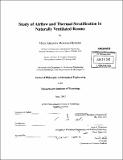Study of airflow and thermal stratification in naturally ventilated rooms
Author(s)
Menchaca Brandan, María Alejandra
DownloadFull printable version (45.76Mb)
Other Contributors
Massachusetts Institute of Technology. Dept. of Mechanical Engineering.
Advisor
Leon R. Glicksman.
Terms of use
Metadata
Show full item recordAbstract
Natural ventilation (NV) can considerably contribute to reducing the cooling energy consumption of a building and increase occupant productivity, if correctly implemented. Such energy savings depend on the number of hours that NV can maintain the indoor air temperature within comfort levels. CoolVent, currently the only simple multizone simulation tool that can adequately model the physics of NV in buildings, assumes a uniform temperature distribution in each room or zone. This temperature corresponds to the exhaust air temperature of each room using an energy balance. In reality, however, the air in a room is often thermally stratified, and the air temperature at occupant level can be significantly lower than the exhaust temperature. The final goal of this thesis was to develop a set of criteria to predict the vertical temperature profile in naturally ventilated rooms by comparing the strength of buoyant to inertial forces in the space, based on a few critical room airflow and physical parameters. Developing such criteria required conducting a thorough study of the physics of turbulent jets and plumes, their development in room-sized enclosures, and their effect on the airflow and heat transfer dynamics in a room. Additionally, it was necessary to investigate, using Computational Fluid Dynamics, the effect of certain parameters -such as radiative heat transfer, heat source distribution and room geometry, among others- on the physics of room airflow simulations. Results shed light on the complexity of modeling room airflow and thermal physics analytically, particularly when the air is thermally stratified. Thermal stratification predictions indicate that multi-zone models overestimate the air temperature at occupant height by up to 40% of the total room air temperature change. This work enhances the physical understanding of modeling critical elements of room airflow and improves the predictive accuracy of the natural ventilation potential in buildings. These contributions promote a wider use of passive cooling strategies, thereby increasing the energy efficiency of the built environment.
Description
Thesis (Ph. D.)--Massachusetts Institute of Technology, Dept. of Mechanical Engineering, 2012. Cataloged from PDF version of thesis. Includes bibliographical references (p. 253-257).
Date issued
2012Department
Massachusetts Institute of Technology. Department of Mechanical EngineeringPublisher
Massachusetts Institute of Technology
Keywords
Mechanical Engineering.